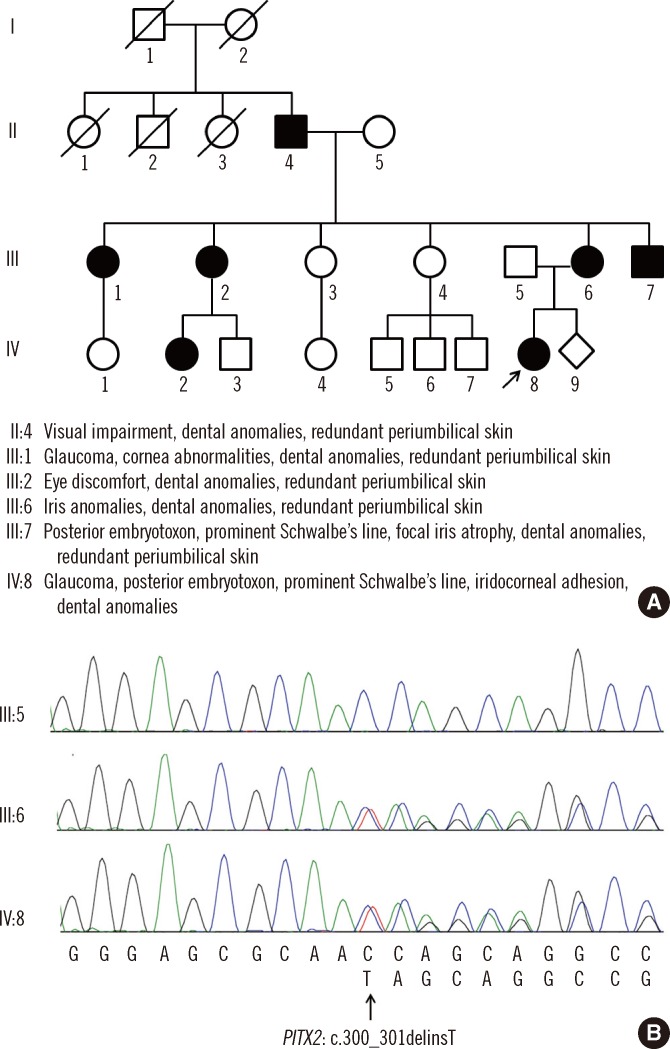Ann Lab Med.
2013 Sep;33(5):360-363. 10.3343/alm.2013.33.5.360.
Novel c.300_301delinsT Mutation in PITX2 in a Korean Family with Axenfeld-Rieger Syndrome
- Affiliations
-
- 1Department of Laboratory Medicine and Genetics, Samsung Medical Center, Sungkyunkwan University School of Medicine, Seoul, Korea. changski@skku.edu
- 2Department of Ophthalmology, Samsung Medical Center, Sungkyunkwan University School of Medicine, Seoul, Korea.
- 3Department of Obstetrics and Gynecology, Samsung Medical Center, Sungkyunkwan University School of Medicine, Seoul, Korea. ckee@skku.edu
- KMID: 1781343
- DOI: http://doi.org/10.3343/alm.2013.33.5.360
Abstract
- Axenfeld-Rieger syndrome (ARS) is characterized by anomalies of the anterior segment of the eye and systemic abnormalities. Mutations in the FOXC1 and PITX2 genes are underlying causes of ARS, but there has been few reports on genetically confirmed ARS in Korea. We identified a novel PITX2 mutation (c.300_301delinsT) in 2 Korean patients from a family with ARS. We expand the spectrum of PITX2 mutations and, to the best of our knowledge, this is the first confirmed family of PITX2-related ARS in Korea.
MeSH Terms
Figure
Reference
-
1. Fitch N. The Axenfeld syndrome and the Rieger syndrome. J Med Genet. 1978; 15:30–34. PMID: 416212.
Article2. Chang TC, Summers CG, Schimmenti LA, Grajewski AL. Axenfeld-Rieger syndrome: new perspectives. Br J Ophthalmol. 2012; 96:318–322. PMID: 22199394.3. Semina EV, Reiter R, Leysens NJ, Alward WL, Small KW, Datson NA, et al. Cloning and characterization of a novel bicoid-related homeobox transcription factor gene, RIEG, involved in Rieger syndrome. Nat Genet. 1996; 14:392–399. PMID: 8944018.
Article4. Mirzayans F, Gould DB, Héon E, Billingsley GD, Cheung JC, Mears AJ, et al. Axenfeld-Rieger syndrome resulting from mutation of the FKHL7 gene on chromosome 6p25. Eur J Hum Genet. 2000; 8:71–74. PMID: 10713890.
Article5. Strungaru MH, Dinu I, Walter MA. Genotype-phenotype correlations in Axenfeld-Rieger malformation and glaucoma patients with FOXC1 and PITX2 mutations. Invest Ophthalmol Vis Sci. 2007; 48:228–237. PMID: 17197537.6. Weisschuh N, Dressler P, Schuettauf F, Wolf C, Wissinger B, Gramer E. Novel mutations of FOXC1 and PITX2 in patients with Axenfeld-Rieger malformations. Invest Ophthalmol Vis Sci. 2006; 47:3846–3852. PMID: 16936096.7. Weisschuh N, De Baere E, Wissinger B, Tümer Z. Clinical utility gene card for: Axenfeld-Rieger syndrome. Eur J Hum Genet. 2011; 19.
Article8. Lines MA, Kozlowski K, Kulak SC, Allingham RR, Héon E, Ritch R, et al. Characterization and prevalence of PITX2 microdeletions and mutations in Axenfeld-Rieger malformations. Invest Ophthalmol Vis Sci. 2004; 45:828–833. PMID: 14985297.9. Phillips JC, del Bono EA, Haines JL, Pralea AM, Cohen JS, Greff LJ, et al. A second locus for Rieger syndrome maps to chromosome 13q14. Am J Hum Genet. 1996; 59:613–619. PMID: 8751862.10. Tanwar M, Dada T, Dada R. Axenfeld-Rieger syndrome associated with congenital glaucoma and cytochrome P4501B1 gene mutations. Case Rep Med. 2010; 2010:pii: 212656. doi: 10.1155/2010/212656.
Article11. Diehl AG, Zareparsi S, Qian M, Khanna R, Angeles R, Gage PJ. Extraocular muscle morphogenesis and gene expression are regulated by Pitx2 gene dose. Invest Ophthalmol Vis Sci. 2006; 47:1785–1793. PMID: 16638982.12. Tümer Z. Axenfeld-Rieger syndrome and spectrum of PITX2 and FOXC1 mutations. Eur J Hum Genet. 2009; 17:1527–1539. PMID: 19513095.13. Gould DB, Mears AJ, Pearce WG, Walter MA. Autosomal dominant Axenfeld-Rieger anomaly maps to 6p25. Am J Hum Genet. 1997; 61:765–768. PMID: 9326342.
Article14. Cho HJ. A case of Axenfeld-Rieger syndrome. J Korean Ophthalmol Soc. 2000; 41:258–263.15. Kim GN, Ki CS, Seo SW, Yoo JM, Han YS, Chung IY, et al. A novel forkhead box C1 gene mutation in a Korean family with Axenfeld-Rieger syndrome. Mol Vis. 2013; 19:935–943. PMID: 23687430.16. Lee JH, Chae SH, Huh J, Kang IS, Lee HJ, Yang JH, et al. A case of Axenfeld-Rieger syndrome with severe mitral regurgitation. J Korean Pediatr Cardiol Soc. 2006; 10:216–219.17. Park SW, Kim HG, Heo H, Park YG. Anomalous scleral insertion of superior oblique in Axenfeld-Rieger syndrome. Korean J Ophthalmol. 2009; 23:62–64. PMID: 19337485.
Article18. Borges AS, Susanna R Jr, Carani JC, Betinjane AJ, Alward WL, Stone EM, et al. Genetic analysis of PITX2 and FOXC1 in Rieger Syndrome patients from Brazil. J Glaucoma. 2002; 11:51–56. PMID: 11821690.19. Berry FB, Lines MA, Oas JM, Footz T, Underhill DA, Gage PJ, et al. Functional interactions between FOXC1 and PITX2 underlie the sensitivity to FOXC1 gene dose in Axenfeld-Rieger syndrome and anterior segment dysgenesis. Hum Mol Genet. 2006; 15:905–919. PMID: 16449236.
- Full Text Links
- Actions
-
Cited
- CITED
-
- Close
- Share
- Similar articles
-
- Anomalous Scleral Insertion of Superior Oblique in Axenfeld-Rieger Syndrome
- A Family with Axenfeld-Rieger Syndrome: Report of the Clinical and Genetic Findings
- A Case of Axenfeld-Rieger Syndrome with Severe Mitral Regurgitation
- Department of Ophthalmology, Taegu Fatima Hospital
- PITX2-related Axenfeld-Rieger Syndrome with a Novel Pathogenic Variant (c.475_476delCT)


